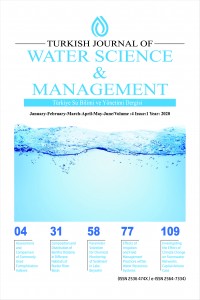Abstract
References
- AMPS, (2004), “Discussion Document on Sediment Monitoring Guidance for the EU Water Framework Directive” AMPS Subgroup on sediment monitoring
- Chapman PM. 1996. Presentation and Interpretation of Sediment Quality Triad Data. Exotoxicology 5: 327-339
- European Commission. (2000). Water Framework Directive (WFD) Directive 2000/60/EC of the European Parliament and of the Council of 23 October 2000 establishing a framework for Community action in the field of water policy, Official Journal of the European Parliament, L327, 22.12.2000.
- EC (European Communities). (2010). Common Implementation Strategy for the Water Framework Directive (2000/60/EC), Guidance document No. 25, Chemical Monitoring of Sediment and Biota Under The Water Framework Directive, Office for Official Publications of the European Communities, ISBN 978-92-79-16224-4, DOI 10.2779/43586.
- European Union (2013). Dırectıve 2013/39/EU of The European Parlıament and of The Council of 12 August 2013 amending Directives 2000/60/EC and 2008/105/EC as regards priority substances in the field of water policy, Official Journal of the European Union, L 226/16, 24.8.2013.
- IUPAC, Pesticide Properties Database [Accessed 10 May 2018]. Available from: https://sitem.herts.ac.uk/aeru/iupac/search.htm Jos Brils (2008), “Sediment monitoring and the European Water Framework Directive”, Ann Ist Super Sanità, 44(3), 218-223
- MoFWA (Ministry of Forestry and Water Affairs of Turkey). (2013). BPAP (Basin Protection Action Plan) for Konya Basin. TÜBİTAK Marmara Research Center, Kocaeli, Turkey.
- MoFWA (Ministry of Forestry and Water Affairs of Turkey). (2014). Project on Basin Monitoring and Determination of Referance Points. Segal Environmental Measurement and Analysis Laboratory Engineering Consultancy Ltd., Ankara, Turkey.
- USEPA, ATSDR: Toxic Substances Portal Chemical List [Accessed 05 May 2018]. Available from: https://comptox.epa.gov/dashboard/chemical_lists/ATSDRLST
Abstract
Sediment plays a
crucial role in water quality. Hydrophobic substances that cannot dissolve in
water have potential to accumulate in sediment. Thus, by conducting only water
quality monitoring, it is impossible to detect these substances. Moreover, by sediment
monitoring, the information about historic contamination can be gained by
performing vertical sampling in sediment.
In this study, it is
aimed to select the parameters that should be monitored in sediment in Beysehir
Lake. For this purpose, specific pollutants that can originate around
industries of Beysehir Lake is selected. Also, pesticides specific to plants
that cultivated in Konya Basin is identified. Between these pollutants the ones
that have the tendency to accumulate in sediment are specified. Priority substances
are also studied and list of chemicals that should be monitored in sediment is
determined.
References
- AMPS, (2004), “Discussion Document on Sediment Monitoring Guidance for the EU Water Framework Directive” AMPS Subgroup on sediment monitoring
- Chapman PM. 1996. Presentation and Interpretation of Sediment Quality Triad Data. Exotoxicology 5: 327-339
- European Commission. (2000). Water Framework Directive (WFD) Directive 2000/60/EC of the European Parliament and of the Council of 23 October 2000 establishing a framework for Community action in the field of water policy, Official Journal of the European Parliament, L327, 22.12.2000.
- EC (European Communities). (2010). Common Implementation Strategy for the Water Framework Directive (2000/60/EC), Guidance document No. 25, Chemical Monitoring of Sediment and Biota Under The Water Framework Directive, Office for Official Publications of the European Communities, ISBN 978-92-79-16224-4, DOI 10.2779/43586.
- European Union (2013). Dırectıve 2013/39/EU of The European Parlıament and of The Council of 12 August 2013 amending Directives 2000/60/EC and 2008/105/EC as regards priority substances in the field of water policy, Official Journal of the European Union, L 226/16, 24.8.2013.
- IUPAC, Pesticide Properties Database [Accessed 10 May 2018]. Available from: https://sitem.herts.ac.uk/aeru/iupac/search.htm Jos Brils (2008), “Sediment monitoring and the European Water Framework Directive”, Ann Ist Super Sanità, 44(3), 218-223
- MoFWA (Ministry of Forestry and Water Affairs of Turkey). (2013). BPAP (Basin Protection Action Plan) for Konya Basin. TÜBİTAK Marmara Research Center, Kocaeli, Turkey.
- MoFWA (Ministry of Forestry and Water Affairs of Turkey). (2014). Project on Basin Monitoring and Determination of Referance Points. Segal Environmental Measurement and Analysis Laboratory Engineering Consultancy Ltd., Ankara, Turkey.
- USEPA, ATSDR: Toxic Substances Portal Chemical List [Accessed 05 May 2018]. Available from: https://comptox.epa.gov/dashboard/chemical_lists/ATSDRLST
Details
| Primary Language | English |
|---|---|
| Journal Section | TURKISH JOURNAL OF WATER SCIENCES AND MANAGEMENT |
| Authors | |
| Publication Date | January 17, 2020 |
| Published in Issue | Year 2020 Volume: 4 Issue: 1 |


